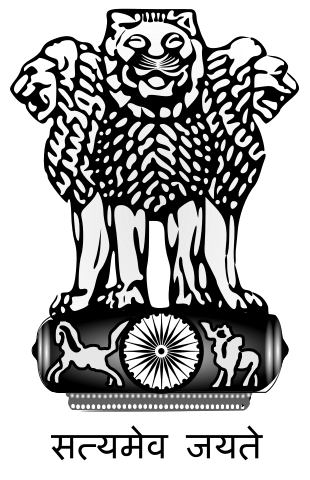From Wikipedia, the free encyclopedia
 |
This is a file from the Wikimedia Commons. The description on its description page there is shown below.Commons is a freely licensed media file repository. You can help.
|
Summary
Title: Emblem of India ( SVG - vectorized version).
The National Emblem of India is derived from the time of the Emperor Ashoka. The emblem is a replica of the Lion of Sarnath, near Varanasi in Uttar Pradesh. The Lion Capital was erected in the third century BC by Emperor Ashoka to mark the spot where Buddha first proclaimed his gospel of peace and emancipation to the four quarters of the universe. The national emblem is thus symbolic of contemporary India’s reaffirmation of it’s ancient commitment to world peace and goodwill. The four lions(one hidden from view ) – symbolising power, courage and confidence- rest on a circular abacus. The abacus is girded by four smaller animals- Guardians of the four directions: The Lion of the North, The Elephant of the East, The Horse of the South and The Bull of the West **. The abacus rests on a lotus in full bloom, exemplifying the fountainhead of life and creative inspiration.
The motto ‘Satyameva Jayate’ inscribed below the emblem in Devanagari script means ‘truth alone triumphs’.
Slovenščina: državni grb Indije
This image shows a flag, a coat of arms, a seal or some other official insignia. The use of such symbols is restricted in many countries. These restrictions are independent of the copyright status.
Български | Česky | Deutsch | English | Esperanto | Español | Français | 日本語 | Português | Русский | ไทย | 中文(繁體) | 中文(简体) | 粵語 | Українська | +/- |
Licensing
I, the copyright holder of this work, hereby publish it under the following licenses:
|
|
Permission is granted to copy, distribute and/or modify this document under the terms of the GNU Free Documentation License, Version 1.2 or any later version published by the Free Software Foundation; with no Invariant Sections, no Front-Cover Texts, and no Back-Cover Texts. A copy of the license is included in the section entitled " GNU Free Documentation License".
Aragonés | العربية | Asturianu | Беларуская (тарашкевіца) | Български | বাংলা | ইমার ঠার/বিষ্ণুপ্রিয়া মণিপুরী | Brezhoneg | Bosanski | Català | Cebuano | Česky | Dansk | Deutsch | Ελληνικά | English | Esperanto | Español | Eesti | Euskara | فارسی | Suomi | Français | Gaeilge | Galego | עברית | Hrvatski | Magyar | Bahasa Indonesia | Ido | Íslenska | Italiano | 日本語 | ქართული | ភាសាខ្មែរ | 한국어 | Kurdî / كوردی | Latina | Lëtzebuergesch | Lietuvių | Македонски | Bahasa Melayu | Nnapulitano | Nederlands | Norsk (nynorsk) | Norsk (bokmål) | Occitan | Polski | Português | Română | Русский | Slovenčina | Slovenščina | Shqip | Српски / Srpski | Svenska | తెలుగు | ไทย | Tagalog | Türkçe | Українська | اردو | Tiếng Việt | Volapük | Yorùbá | 中文(简体) | 中文(繁體) | +/- |
|
|
This file is licensed under Creative Commons Attribution 2.5 License
In short: you are free to distribute and modify the file as long as you attribute its author(s) or licensor(s).
|
You may select the license of your choice.
|
 |
This image is in the public domain in India because its term of copyright has expired.
- Indian copyright act applies in India, to images first published in India.
- According to The Indian Copyright Act, 1957 (Chapter V Section 25), Anonymous works, photographs, cinematographic works, sound recordings, government works, and works of corporate authorship or of international organizations enter the public domain 60 years after the date on which they were first published, counted from the beginning of the following calendar year (ie. as of 2008, works published prior to 1 January 1948 are considered public domain). Posthumous works (other than those above) enter the public domain after 60 years from publication date. Any other kind of work enters the public domain 60 years after the author's death. Text of laws, judicial opinions, and other government reports are free from copyright.
|
|
|
|
This image might not be in the public domain outside India. The creator and year of publication are essential information and must be provided. See Wikipedia:Public domain and Wikipedia:Copyrights for more details. |
This image shows a flag, a coat of arms, a seal or some other official insignia. The use of such symbols is restricted in many countries. These restrictions are independent of the copyright status.
Български | Česky | Deutsch | English | Esperanto | Español | Français | 日本語 | Português | Русский | ไทย | 中文(繁體) | 中文(简体) | 粵語 | Українська | +/- |
File history
Click on a date/time to view the file as it appeared at that time.
|
|
Date/Time |
Thumbnail |
Dimensions |
User |
Comment |
| current |
06:08, 25 November 2006 |
 |
310×480 (214 KB) |
Nichalp |
|
|
|
20:41, 28 August 2006 |
 |
310×480 (214 KB) |
Madden |
|
|
|
20:38, 28 August 2006 |
 |
310×480 (214 KB) |
Madden |
|
|
|
07:17, 28 March 2006 |
 |
310×480 (214 KB) |
Miljoshi |
|
File links
The following pages on Schools Wikipedia link to this image (list may be incomplete):







